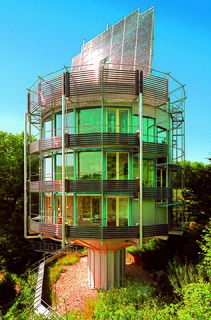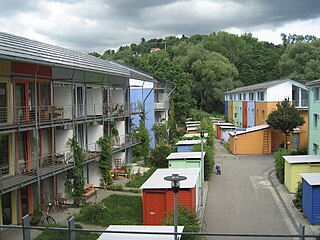Environmental design is the process of addressing surrounding environmental parameters when devising plans, programs, policies, buildings, or products. Classical prudent design may have always considered environmental factors; however, the environmental movement beginning in the 1940s has made the concept more explicit.

An energy-plus house produces more energy from renewable energy sources, over the course of a year, than it imports from external sources. This is achieved using a combination of microgeneration technology and low-energy building techniques, such as: passive solar building design, insulation and careful site selection and placement. A reduction of modern conveniences can also contribute to energy savings, however many energy-plus houses are almost indistinguishable from a traditional home, preferring instead to use highly energy-efficient appliances, fixtures, etc., throughout the house.

Passive house is a rigorous, voluntary standard for energy efficiency in a building, which reduces the building's ecological footprint. It results in ultra-low energy buildings that require little energy for space heating or cooling. A similar standard, MINERGIE-P, is used in Switzerland. The standard is not confined to residential properties; several office buildings, schools, kindergartens and a supermarket have also been constructed to the standard. Passive design is not an attachment or supplement to architectural design, but a design process that integrates with architectural design. Although it is principally applied to new buildings, it has also been used for refurbishments.

A zero-energy building, also known as a zero net energy (ZNE) building, net-zero energy building (NZEB), net zero building or zero-carbon building is a building with zero net energy consumption, meaning the total amount of energy used by the building on an annual basis is roughly equal to the amount of renewable energy created on the site, or in other definitions by renewable energy sources elsewhere. These buildings consequently contribute less overall greenhouse gas to the atmosphere than similar non-ZNE buildings. They do at times consume non-renewable energy and produce greenhouse gases, but at other times reduce energy consumption and greenhouse gas production elsewhere by the same amount. A similar concept approved and implemented by the European Union and other agreeing countries is nearly Zero Energy Building (nZEB), with the goal of having all buildings in the region under nZEB standards by 2020.

Schwarzwald-Stadion is a football stadium in Freiburg, Baden-Württemberg, Germany. It is currently the home of Bundesliga team SC Freiburg. The stadium holds 24,000 spectators and was built in 1953. For many years it was called the Dreisamstadion, situated near the river Dreisam.
Solar air conditioning refers to any air conditioning (cooling) system that uses solar power.

The Sun Ship is a small community that is run entirely by solar energy. It was built in 2004 in Freiburg im Breisgau's renowned Vauban quarter. Sonnenschiff was designed by architect Rolf Disch, who also built the Heliotrope, and generates four times more energy than it uses.

The Solar Settlement at Schlierberg is a 59-home PlusEnergy housing community in Freiburg, Germany. Solar architect Rolf Disch wanted to apply his PlusEnergy concept, created originally with his Heliotrope home, to mass residential production. This residential complex won such awards as House of the Year (2002), Residential PV solar integration award (2002), Germany’s most beautiful housing community (2006). It is the first housing community in the world in which all the homes produce a positive energy balance and which is emissions-free and CO
2 neutral. Built between 2000 and 2005 in the Vauban quarter of Freiburg the design of each home offers maximum energy efficiency and turns energy bills into energy income. The Solar Settlement has proved Disch’s vision of a “fundamental environmental imperative” as these homes have exhibited more than 8 years of full occupancy and each produced more than 4,000 Euros ($5,600) each year in solar energy profits. Disch believes the image his community exhibits is equally as important as the eco-savings it brings. Disch says 50 homes that eliminate energy bills and feed clean sustainable renewable energy into the city’s grid is the imperative we need. They contribute towards the goal of sustainable ecological and economic development and show the entire world that communities like this are economical, beautiful, comfortable and in fact preferable. The tenants at the Solar Settlement do not claim to have made any compromises in their living situations but rather that they have both environmentally and economically improved. Made from Black Forest timber, the wood interior and natural lighting provide for happily lit spaces and a natural flow from room to room.
German developments that employ green building techniques include:

A community solar farm or garden is a solar power installation that accepts capital from and provides output credit and tax benefits to individual and other investors. In some systems you buy individual solar panels which are installed in the farm after your purchase. In others you purchase kW capacity or kWh of production. The farm's power output is credited to investors in proportion to their investment, with adjustments to reflect ongoing changes in capacity, technology, costs and electricity rates. Companies, cooperatives, governments or non-profits operate the farms.
The following outline is provided as an overview of and topical guide to solar energy:
Climate-adaptive building shell (CABS) is a term in building engineering that describes the group of facades and roofs that interact with the variability in their environment in a dynamic way. Conventional buildings have static building envelopes, and can therefore not act in response to changing weather conditions and occupant requirements. Climate adaptive building shells, on the other hand do have the ability to change with time. Well-designed CABS have two main functions: they contribute to energy-saving for heating, cooling, ventilation and lighting; and they induce a positive impact on the indoor environmental quality of buildings.























